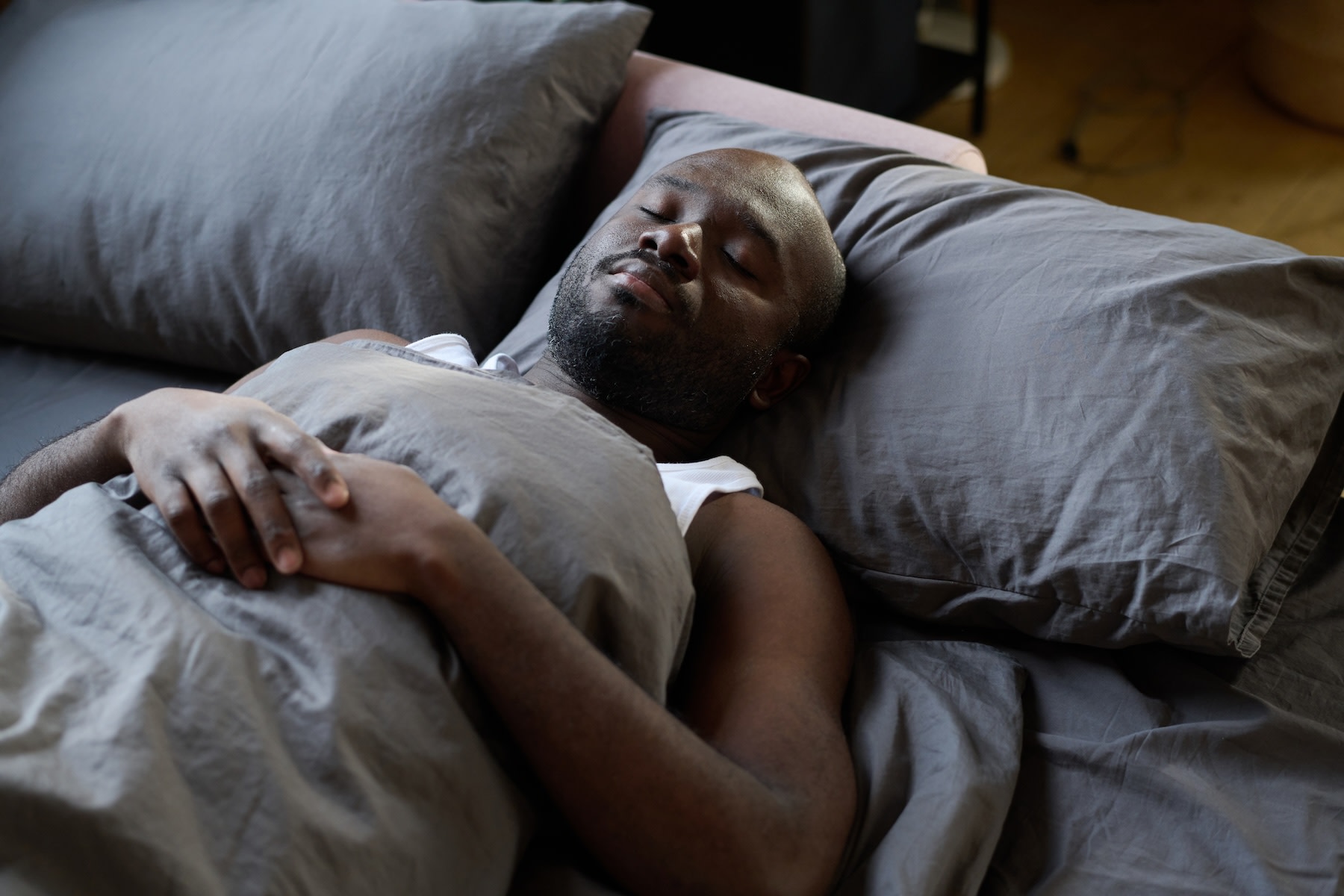
kyonntra / E+ via Getty Images
How to Practice Progressive Muscle Relaxation to Boost Sleep and Reduce Stress
This simple relaxation technique can do wonders for sleep and anxiety in a matter of minutes.
By Michele Ross•
What Is Progressive Muscle Relaxation?
Progressive Muscle Relaxation Benefits
How to Practice Progressive Muscle Relaxation
When Should You Try Progressive Muscle Relaxation?
Tips for Practicing Progressive Muscle Relaxation
Is Progressive Muscle Relaxation Right for Everyone?
The Takeaway
Sleeping well and managing stress are two of the most powerful ways to support your physical and mental wellbeing. But for many of us, both are easier said than done—especially when your body is prone to constant tension or your mind runs a mile a minute.
Discover more ways to reach your goals with Peloton
Fortunately, there are an array of techniques you can try when rest or relaxation feel out of reach, from sleep meditation or journaling. Another effective yet simple practice that can help when you’re seeking calmer days or more restful nights? Progressive muscle relaxation.
Ahead, learn how and when to try this effective technique, plus the key benefits you might notice as a result.
What Is Progressive Muscle Relaxation?
Progressive muscle relaxation (PMR) is a technique that involves actively tensing your muscles before releasing them, one area of the body at a time. “This brief activation increases blood flow, generates warmth, and heightens awareness in those areas,” says Peloton instructor Erik Jager. When the tension is released, the muscles are more likely to fully relax, he explains.
Squeezing then releasing your muscles via PMR can also trigger a physiological response by potentially reducing levels of the stress hormone cortisol and lowering your heart rate, Erik continues. Once your body begins to settle down, your mind can follow suit, whether you’re trying to calm your nerves or fall asleep.
Progressive muscle relaxation may be included in some meditation classes. However, it differs from most types of meditation in that it takes an outside-in approach, says Mary Odafe, PhD, a licensed clinical psychologist and clinical and scientific affairs liaison at Modern Health. “While most meditation methods focus on calming the mind, PMR works from the outside in by using the body as a direct path to calm the nervous system,” she explains.
Since you deliberately tense one muscle or muscle group at a time, you’re also training yourself to recognize what physical tension feels like so you can ultimately let it go and feel relaxed.
Progressive Muscle Relaxation Benefits
Progressive muscle relaxation has the potential to offer an array of benefits for your mind and body. Here’s what you can expect when you try this calming technique yourself.
1. It Releases Physical Tension
First and foremost, progressive muscle relaxation is a gentle yet effective way to release tension in the body (and that’s no small feat!).
“Progressive muscle relaxation is a powerful tool, especially for people who deal with a lot of repetitive or one-sided physical stress in their daily routines, like sitting at a desk for long hours, spending time in the car, or working jobs that don’t engage the whole body but overload certain areas such as the neck, shoulders, or lower back,” Erik says. Better yet, you’re likely to experience some level of physical release immediately.
It can also be a game-changer for those who tend to experience physical manifestations of inner stress. “The constant mental pressure and high stress levels we’re exposed to in today’s world make it harder for our bodies to naturally let go,” Erik continues.
PMR is also an underrated remedy for tension-related issues like headaches, clenched jaws, and restless legs, Odafe adds.
2. It Promotes a Sense of Calm
According to Odafe, progressive muscle relaxation is like a manual reset for your nervous system. “It lowers your heart rate, reduces cortisol, and helps the body shift out of fight-or-flight mode, which is essential in today’s high-stress world,” she says.
3. It Boosts Mental Health
Progressive muscle relaxation not only has the power to help you achieve a sense of calm and mind-body harmony in the moment, it can also have potent effects on your mental health as a whole.
According to a 2024 research review published in the journal Psychology Research and Behavior Management, PMR was found to be effective in reducing anxiety, stress, and depression in adults. The benefits were even greater when participants combined PMR with other interventions, so it’s well worth pairing it with other mental wellbeing practices, including but not limited to meditation, breathwork, and/or therapy. (To be clear, though: Progressive muscle relaxation shouldn’t be used as a replacement for mental health treatments like therapy or medication for those who need them.)
4. It Helps You Stay Present
Because progressive muscle relaxation is an active, intentional practice, it anchors you in the here and now, rather than letting your anxious or racing thoughts take over. “It encourages present-moment awareness and deeper focus on breathing and bodily sensations, which further calms the nervous system,” Erik says.
Staying present also encourages mental clarity and emotional regulation. In turn, Odafe says that these effects—paired with the release of stored tension—promote sharper focus and a more balanced mind-body connection.
Plus, this approach may be particularly powerful for those who get side-tracked by distracting thoughts during meditation classes, as your focus remains on physical sensations in your body throughout the entire practice.
5. It Promotes Good Sleep
Progressive muscle relaxation can also be a great tool for getting better sleep. “Back when I started out as a group fitness instructor, I often used PMR in my classes,” Erik says. “There were always a few participants who relaxed so deeply during the process that they actually fell asleep. That’s when you know it works.”
Research backs this up: Many studies have demonstrated the positive effects of progressive muscle relaxation on sleep quality and fatigue. What’s more, these findings were found in people across various populations, including young adults, postmenopausal women, healthcare professionals, and adults with rheumatoid arthritis.

AnnaStills / iStock / Getty Images Plus via Getty Images
6. It’s Accessible
Accessibility is another major benefit of progressive muscle relaxation. It’s not only free and straightforward, but you can also do it whenever and wherever. You can even practice it at work or while you’re standing, Erik says, though the greatest benefits come when you’re fully at rest in a quiet environment.
For some, PMR may also be more approachable and easier to stick to if other wellness modalities, such as meditation, haven’t felt helpful. “If you’ve ever felt like traditional meditation is too passive or hard to stick with, PMR offers a more active and structured alternative,” Odafe says. “You’re not just being told to relax—you’re actively doing it, one muscle group at a time.”
How to Practice Progressive Muscle Relaxation
This technique is simple to practice, but it helps to know the rules of the road before getting started. Here are Erik’s step-by-step instructions on how to do progressive muscle relaxation.
1. Focus, Inhale, and Contract
Direct your attention to the area you’re about to tense. Inhale slowly and begin to contract that muscle group, aiming for about 80–90 percent of your maximum effort (sort of like you’re clenching your first). Just make sure you’re not overstraining to the point of pain or cramping.
2. Hold, Exhale, and Release
Hold the tension for about 5 seconds, then release everything as you deeply exhale.
3. Pause and Tune into Sensations
Give that area 15–20 seconds to fully relax, paying attention to any sensations (such as heaviness or warmth). During this time, continue to breathe slowly and evenly.
4. Repeat
If you’re doing full body progressive muscle relaxation, proceed with the next body part closest to the first. You can move from head to toe (think: forehead, mouth, neck, shoulders, and so forth) or toe to head (as in: feet, calves, thighs, and so on). Or, you can do a targeted focus on just one area of the body that’s holding a lot of tension (such as your neck, shoulders, or lower back) and repeat the same tension-release cycle as many times as needed.
Want to intensify the effects? Erik says you can try tensing multiple muscle groups simultaneously. “For example, engage the entire lower body—quads, hamstrings, calves, and glutes—in one go, or combine the upper body as well for a full body contraction,” he says. “But only if it feels right for you.”
When Should You Try Progressive Muscle Relaxation?
Progressive muscle relaxation is typically used before bed or when you need to de-stress or wind down.
“I use PMR intentionally, especially when I feel too stimulated in the evening, either from intense training or after an emotionally charged day,” Erik says. “By deliberately tensing specific muscle groups, I create a contrast that leads to a deeper sense of relaxation. … In those moments, PMR helps me settle my system and ease into a more restful state so I can fall asleep more easily.”
You could also try it after you get home from a taxing day of work or whenever you want to ground yourself in the present and align your mind with your body. On this latter note, Odafe says that PMR can be especially useful before high-stakes moments such as important meetings, presentations, races, or performances.
Essentially, PMR shines whenever you want to relax or recalibrate in a short amount of time. “The deeper effects come when you’re fully at rest, but I’ve used this method with clients in everyday settings to give them a practical way to take just 5 minutes and actively downshift their nervous system,” Erik says.
Tips for Practicing Progressive Muscle Relaxation
To make the most of your progressive muscle relaxation practice, Erik suggests:
Practicing in a calm, quiet setting where you feel safe and at ease
Pairing it with calming music, as desired
Not performing or pushing yourself, but rather doing what feels right for your body
If you’re practicing PMR in scenarios aside from falling asleep, be sure to take your time as you get up and resume your normal activities. Since your heart rate and blood pressure might have lowered, Erik says, you’ll want to “ease back into movement gently and give your system time to reorient.”
If you’re new to the practice, it can also be helpful to start with a guided progressive muscle relaxation, such as those offered within certain classes on the Peloton App.
Try Progressive Muscle Relaxation In a Peloton Class
Is Progressive Muscle Relaxation Right for Everyone?
Progressive muscle relaxation is generally safe for most people. That said, people with certain physical conditions or limitations should take extra care.
“Anyone recovering from injury, surgery, or managing chronic pain should check in with a clinician before starting,” Odafe advises. “The practice involves deliberate muscle tension, which can be helpful, but only when done mindfully.”
The Takeaway
Progressive muscle relaxation is a gentle yet powerful way to yield a host of potential mind-body benefits, including less physical tension, reduced stress and anxiety, and better sleep. It’s also an effective tool to establish a stronger, more grounded connection between your mind and body. Instead of resisting physical stress or letting discomfort invade your thoughts, PMR allows you to consciously lean into tension for the sake of releasing it—first in your body, with your mind soon to follow.
For optimal results, include PMR in your nightly wind-down routine or practice it when you need to calm down or gather your composure. Within a few minutes’ time, you just might find that your stress has melted away or you’ve successfully lulled yourself to sleep.

Peloton App
Access thousands of classes with no equipment needed.
This content is for informational and educational purposes only and does not constitute individualized advice. It is not intended to replace professional medical evaluation, diagnosis, or treatment. Seek the advice of your physician for questions you may have regarding your health or a medical condition. If you are having a medical emergency, call your physician or 911 immediately.
Level up your inbox.
Subscribe for a weekly dose of fitness, plus the latest promos, launches, and events.
By providing your email address, you agree to receive marketing communications from Peloton.
For more about how we use your information, see our Privacy Policy.











